SF Gate- Private property on California’s Central Coast near Big Sur set to become public
SF Gate celebrates the Trust’s recent purchase of the 160-acre Church Creek property in the Ventana Wilderness of California.
August 29, 2023
SF Gate celebrates the Trust’s recent purchase of the 160-acre Church Creek property in the Ventana Wilderness of California.
August 29, 2023
The San Francisco Chronicle celebrates the Trust’s recent purchase of the 160-acre Church Creek property in the Ventana Wilderness of California.
August 26, 2023
August 25, 2023
This week The Wilderness Land Trust completed the purchase of 160 acres in the Ventana Wilderness of California.
In the heart of California’s Central Coast, the 160-acre Church Creek property overlooks the wild sharp-crested ridges and steep valleys of the interior coastal range. The property connects to over 2,000,000 acres of public lands that provide critical wildlife habitat in the middle of a biodiversity hotspot. With several streams, the Church Creek property maintains important habitat resources for resident and migrating species in this dry landscape. The property also provides public access with a trailhead connecting two popular trails.
The property was owned by the San Francisco Zen Center in connection to its nearby Tassajara Mountain Zen Center. Together the San Francisco Zen Center and The Wilderness Land Trust have ensured the threat of development is removed, and the property will become public lands for all to enjoy.
“There’s an old Zen saying: ‘If I take care of the mountains, they will take care of us.’ We share this quality of intimate connection with nature with the Wilderness Land Trust, and we deeply appreciate the protection and care this land will continue receiving in the future.”
– Sozan Miglioli, President of San Francisco Zen Center
With incredible vistas, flat building sites, and access via a public road, the Church Creek property would have been at high risk of development had it sold to a private buyer. The next step for this property is to be transferred to Los Padres National Forest. With over 2,000 acres of private inholdings remaining in the Ventana Wilderness, there is still more work to be done. But for now, thanks to the San Francisco Zen Center’s vision and the support of our donors and partners, there are 160 fewer acres at risk.
January 27, 2023-
This week The Wilderness Land Trust completed the transfer of 1,698 acres of sagebrush steppe in the eastern Sierra to public ownership.
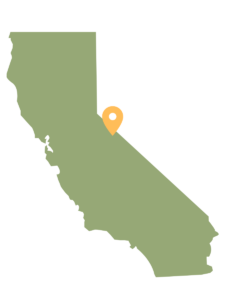 Located in the Bodie Hills, just east of Yosemite National Park, the property stretches across five parcels, dispersed throughout a large ranch holding.
Located in the Bodie Hills, just east of Yosemite National Park, the property stretches across five parcels, dispersed throughout a large ranch holding.
The Bodie Hills have some of the highest ecological intactness and species richness in the region, and are ranked in the top 10% of unprotected BLM lands in California for biodiversity. Despite the ecological importance of the region, it is a patchwork of private property and public lands managed by the Forest Service and Bureau of Land Management with three Wilderness Study Areas covering much of it. Wilderness designation efforts, such as those in the Bodie Hills, are often hindered by the presence of private land fragmenting the landscape as it creates an inability to control critical habitat components to assure the viability of a designation.
Since we began our work in the Bodie Hills in 2006, the Trust has purchased five large properties there totaling just over 7,000 acres. This is the third of them to be successfully transferred to public ownership. Thanks to the support of and partnerships with local conservations groups and tribes, we are steadily unifying ownership in the area, removing piecemeal management and fragmented habitats. It won’t be solved overnight, but the cumulative impact of almost twenty years of work and your support is moving us closer to the goal of protecting this important landscape.
December 30, 2022-
We are wrapping up 2022 celebrating successful protection of the wilderness you love in Colorado and Washington!
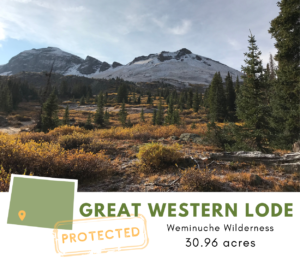 In the San Jan Mountains of Colorado, southeast of the small town of Silverton, the Weminuche Wilderness covers almost half a million acres of pristine alpine habitat, including three 14,000 ft peaks. We recently completed the purchase of three parcels known as the Great Western Lode, totaling 30.96 acres. Protected within the property is a fragile community of grasses, sedges, and dwarf plants that make up Colorado’s alpine tundra. The popular 9.3 mile Whitehead Trail runs through two of the Great Western Lode parcels, connecting the Continental Divide Trail, Highland Mary Trail, and Deer Park Trails. Prior to our purchase, public access on the Whitehead Trail was not secured through the private parcels, leaving these treasured recreation opportunities vulnerable. Thanks to your support, generations to come will have access to explore this rugged, breathtaking landscape!
In the San Jan Mountains of Colorado, southeast of the small town of Silverton, the Weminuche Wilderness covers almost half a million acres of pristine alpine habitat, including three 14,000 ft peaks. We recently completed the purchase of three parcels known as the Great Western Lode, totaling 30.96 acres. Protected within the property is a fragile community of grasses, sedges, and dwarf plants that make up Colorado’s alpine tundra. The popular 9.3 mile Whitehead Trail runs through two of the Great Western Lode parcels, connecting the Continental Divide Trail, Highland Mary Trail, and Deer Park Trails. Prior to our purchase, public access on the Whitehead Trail was not secured through the private parcels, leaving these treasured recreation opportunities vulnerable. Thanks to your support, generations to come will have access to explore this rugged, breathtaking landscape!
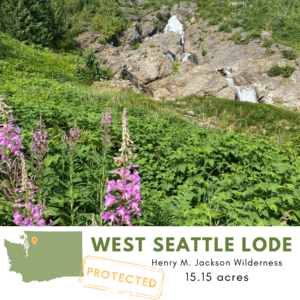 The Trust recently completed the purchase of the 15.15-acre West Seattle Lode, our first acquisition in Washington’s Henry M. Jackson Wilderness. This rugged, glaciated landscape is home to the endangered Northern Spotted Owl, Cascade red fox, pika, wolverines, and Marbled Murrelet, a seabird that nests in old growth forests and alpine slopes. The property is on a steep slope that overlooks the Monte Cristo ghost town, the site of a gold and silver mining boom lasting from 1895-1912.
The Trust recently completed the purchase of the 15.15-acre West Seattle Lode, our first acquisition in Washington’s Henry M. Jackson Wilderness. This rugged, glaciated landscape is home to the endangered Northern Spotted Owl, Cascade red fox, pika, wolverines, and Marbled Murrelet, a seabird that nests in old growth forests and alpine slopes. The property is on a steep slope that overlooks the Monte Cristo ghost town, the site of a gold and silver mining boom lasting from 1895-1912.
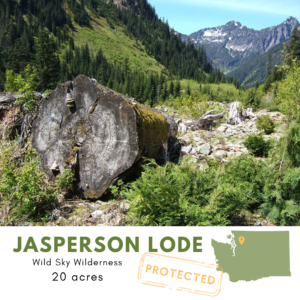 The 20-acre Jasperson Lode property was purchased by The Trust in 2017, and was recently transferred to public ownership. This newest addition to the Wild Sky Wilderness sits in a bowl on the south flank of the imposing Sheep Gap Mountain, just west of the Silver Creek drainage. With the property now incorporated into the wilderness, the patchwork of land management regulations and wildlife habitat has been removed, ensuring seamless conservation across the landscape.
The 20-acre Jasperson Lode property was purchased by The Trust in 2017, and was recently transferred to public ownership. This newest addition to the Wild Sky Wilderness sits in a bowl on the south flank of the imposing Sheep Gap Mountain, just west of the Silver Creek drainage. With the property now incorporated into the wilderness, the patchwork of land management regulations and wildlife habitat has been removed, ensuring seamless conservation across the landscape.
November 17, 2022-
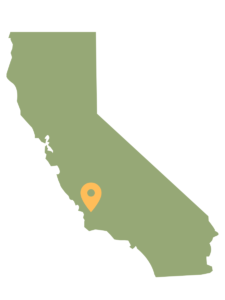
Just inland from the rugged cliffs and secluded beaches of the central California coast, the Santa Lucia and Garcia Wilderness areas are tucked in the rolling hills of chaparral and towering oaks. Less than an hour from San Luis Obispo, the two wilderness areas total over 34,000 acres and are separated by just a few miles, and Trout Creek.
Over the past few years The Trust successfully purchased and transferred three properties to public ownership in the Trout Creek drainage. This week we expanded that success with the transfer of a fourth 148-acre property.
In this dry landscape, streams like Trout Creek are important water sources for resident and migrating species. The area, which is part of a biodiversity hotspot, provides critical habitat for wildlife ranging from the endangered California condor to the threatened California red-legged frog. Protecting these landscapes, and their wild inhabitants, increases the region’s resilience to a changing climate.
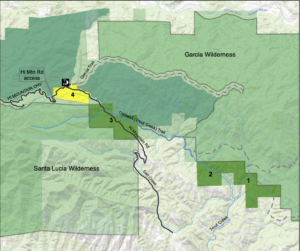
The Central Coast Heritage Protection Act, which is currently making its way through the houses of Congress, includes the proposed designation of additional wilderness connecting the Santa Lucia and Garcia wilderness areas. The Trust’s work in the Trout Creek drainage
has removed the last islands of private property, clearing the way for connectivity across the landscape for wildlife corridors and recreational access.
Thanks to your support and our partners at Los Padres National Forest and USFS Region 5, these lands are now secured for future generations to enjoy!
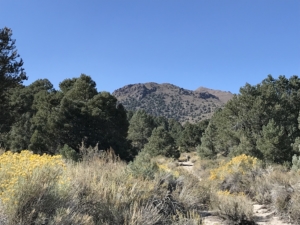
A trail with a stunning view of Mt. Biedeman meanders through the Trust’s newly acquired Bodie Hills property
Bodie Hills land purchase means additional protection for California’s Eastern Sierra
Jan. 20, 2022 – The Wilderness Land Trust has closed on an 880-acre land purchase in the Bodie Hills, located in California’s Eastern Sierra. The Trust is now working with the Bureau of Land Management (BLM) and its conservation partners to permanently protect this property.
Overlooking Mono Lake and the Eastern Sierra on the south side of the Mt. Biedeman Wilderness Study Area (WSA), the Trust’s Bodie Hills property is known for its mature pinon-juniper forest and seasonal streams. The Bodie Hills link the Sierra Nevada to the high desert plains and wetlands of the Great Basin in California and Nevada. The size and connectivity of these wild lands provide a high level of resilience in the face of climate change that allow flora and fauna to thrive. Mule deer herds and pronghorn rely on this property to migrate between their winter and summer habitats. The area also has some of the densest concentrations of cultural and historic sites in the Great Basin.
“By purchasing the Bodie Hills property, we have protected this land from the threat of development and mining, preserved the resilience of the surrounding landscapes and protected access to a truly beautiful spot overlooking Mono Lake and the Eastern Sierra,” says Aimee Rutledge, vice president and senior lands specialist, The Wilderness Land Trust. “A heartfelt thanks to all our supporters and especially to the landowner and our partners – Friends of the Inyo, the Mono Lake Committee, Eastern Sierra Land Trust, DeChambeau Creek Foundation, Wildlands Conservancy and Resources Legacy Fund – for making this acquisition possible.”
“The acquisition of these lands, adjacent to the Mount Biedeman WSA, are an integral piece of the ecological connectivity of the Mono Basin and the Bodie Hills. The justification for permanently protecting this area is made significantly stronger because of unified ownership,” says Jora Fogg, policy director, Friends of the Inyo.
“The scenic beauty of Mono Lake and the Mono Basin National Forest Scenic Area is now better protected thanks to this significant acquisition. This is a great way to start the new year at Mono Lake,” says Geoff McQuilkin, executive director, Mono Lake Committee.
The Wilderness Land Trust has now completed five projects totaling more than 6,500 acres in the Bodie Hills region. However, thousands of acres of private lands still exist within and adjacent to the Bodie Hills, affecting several wilderness study areas, areas of critical environmental concern, and the Granite Mountain Wilderness. Without our efforts to purchase and protect private holdings within these public lands, these wild areas are vulnerable to gold mining, and commercial and residential development that threaten plant and wildlife habitat.
Additional Wilderness Land Trust Bodie Hills Projects
A Unique Ecosystem Worth Saving – Wilderness Land Trust
A Win for Wildlife Habitat in Eastern Sierra – Wilderness Land Trust
Dec. 31, 2021 – We can’t think of a better way to close out 2021 than with the news that we’ve protected a vital property in northern California’s rugged Lassen National Forest. The 35-acre Hat Creek property connects to the proposed Lost Creek Wilderness area that totals more than 20,000 acres.
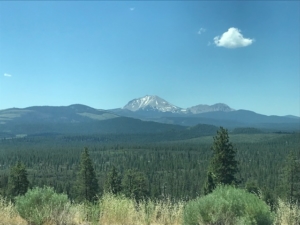
June view from Hat Creek Rim Scenic Viewpoint
This stunningly unique refuge hosts two trout streams – Hat Creek and Lost Creek. By purchasing this land, we have eliminated the threat of private development so this land can continue to host deer, bear, elk, northern spotted owl and many other species.
This landscape is also part of the Klamath-Siskiyou wild area – 11 million acres of connected protected landscapes in northern California and southern Oregon that reaches from the Pacific Coast to the High Sierra. This massive stretch of land includes six designated wilderness areas that provide critical resilience in the face of climate change.
The Hat Creek property is surrounded by Lassen National Forest roadless area on three sides. By purchasing it, we have also provided a potential future fishing and hiking access point to this beautiful land.
Being outside in the wild brings us the greatest joy, especially during difficult times. And as we say goodbye to 2021 and welcome the new year and our 30th anniversary as a Land Trust, I can’t emphasize enough how grateful and joyous we are to have your support. If you are still planning to donate before the end of the year, your dollars will be matched by our board, which has generously agreed to match all gifts up to $35,000.
If you have already donated to the Trust, thank you! Your donation makes more smiles and laughter outside together possible in 2022 and beyond.
July 9, 2021 – The Santa Lucia Wilderness is located near San Luis Obispo, California, and is a unique refuge for plants, animals and humans that covers the interior coastal range mountains. Designated in 1978, it totals 20,241 acres and is known for its mountain peaks, chaparral-covered slopes and ancient oaks. This landscape is part of more than 1.7 million acres of protected coastal landscapes that provide resilience to a rapidly changing climate. 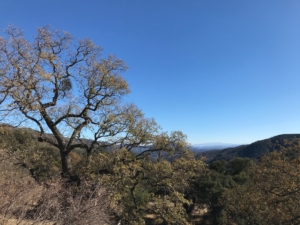
Thanks to your generous support, The Wilderness Land Trust has just purchased 148 acres in the Los Padres National Forest that will add to that total and help provide an important wildlife connection between the existing Santa Lucia Wilderness and a proposed wilderness to the northeast.
Our Trout Creek IV Project builds on our purchase and transfer of three prior properties — Trout Creek I, II, III — that total more than 800 acres, and provides a key link to the planned California Condor Trail, a 400-mile route connecting the southern and northern parts of the Los Padres National Forest. The property’s watershed supports critical habitat for a number of endangered, threatened and sensitive species, including mountain lion, black bear, two-stripe garter snake, California spotted owl, western pond turtle, brown and rainbow trout, and migratory song birds.
Again, thank you for your support of our work to protect federally designated wilderness along the coast of California and ensuring another success story to share with family and friends!
June 25, 2021 – Our 2019 purchase of the 637-acre Little Castle Lake property in California represented the largest remaining private parcel in the Castle Crags Wilderness. This land straddles the wilderness boundary and includes a portion of Castle Lake and all of Little Castle Lake.

A hiker pauses at Heart Lake to admire Mt. Shasta
To people familiar with this area, this purchase meant the protection of the hiking trail to Heart Lake, and access to lake activities, fishing and hunting. It also meant the property would be protected from logging and development, which would have threatened old growth forest, critical habitat and a major source of clean water for California and the west.
We are thrilled to tell you that this property has officially transferred to public ownership through the Shasta-Trinity National Forest. We are also grateful for the help of our project partners at the Siskiyou Land Trust, Mt. Shasta Trails Association, Conservation Alliance and U.S. Forest Service, who contributed to the success of this project.
The Castle Crags Wilderness encompasses more than 12,000 acres and is located at the south end of the 11 million acre Klamath Siskiyou wild area that covers northern California and southern Oregon and connects the Pacific Ocean to the Sierra through six wilderness areas. In June 2018, the Trust transferred 1,256 acres of the Crags to the Shasta-Trinity National Forest, opening access from the east to trails and world class rock climbing.
If you have the opportunity, we encourage you to visit this beautiful region of California and experience the new official trail leading from Castle Lake to Heart Lake.